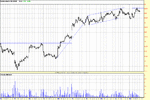Absolute now
SOCRATES said:The background is very important and gives good pointers up to what unfolds next. But what develops next is a stage set for further development. In this stage there are clues that subtly reveal the intent, the ultimate intent, that is.
For me it is like attending a play in a theatre, when the curtain rises and there is no one on the stage but the scenery is in place. Before the actors appear the scenery gives a glimpse in advance that is not complete, but sufficiently suggestive in its implication to give a solid clue as to what one can expect to see within the context of the backdrop and the props provided.
I therefore do not rely so heavily on the background but more of what is currently developing at the leading edge and then as a gestalt (which is a German word meaning something that is greater than the sum of its parts).
And having taken in this Gestalt I now leave it to talk to me in the sense that I allow it to reveal more deeply how the move is panning out and the distinct direction may become immediately manifest very clearly, in which case there is no time to dither but to snap judge and act.
So you see that the element of mechanical reasoning is over very quickly and now something else replaces it. It is at this juncture that the stop is placed in the sequence of enactment.
This enactment invairiably is correct and comes from the subconscious, and not the conscious mind, as the conscious mind has already played its part by contributing to evaluation and judgement, which is the mechanical part that is now over.
The subconscious is now concerned with the inference, which is an abstract concept and very real. As the stop secures the position against serious loss in case the outcome expected is not the one that suddenly develops, the subconscious is free and is able to carry out the task of taking in the inference and decoding the message drawn from it.
As explained in my previous post there are several things I take in, not one after the other but all at the same time and very quickly.
Whilst all this is going on, I am aware that the clock is ticking. My objective is to beat the clock and for this reason it is imperative not to dither but to committ the millisecond that the price indicates the now. Very difficult to explain because it is very abstract, very far removed from what is mechanical.
Last edited:



